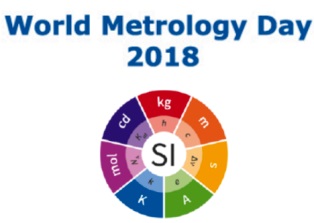Global movement raises awareness of upcoming changes to the International System of Units |21 May 2018
 This month, the world’s measurement community will come together to raise awareness of an expected overhaul to the universally accepted definitions of measurement – the International System of Units (SI).
This month, the world’s measurement community will come together to raise awareness of an expected overhaul to the universally accepted definitions of measurement – the International System of Units (SI).
These standards ensure our everyday concepts of measurement, whether of a metre or a second, remain comparable and consistent worldwide. Just like stable foundations are needed to keep a house upright, the SI needs to be future-proofed to remain relevant and stable for advancements to come.
The average citizen is blissfully unaware that it takes an enormous number of precision measurements to make modern daily life possible. For example, every component of a smart phone depends on an infrastructure of meticulously measured and tested scientific principles, materials, tools, and processes that combine to ensure it can reliably make calls, send texts, access the internet, and use GPS to help you navigate. The ability to make these precision measurements was made possible by redefinitions using natural constants (the ticking frequency of the element, caesium, and the speed of light) for the second and the meter in 1960 and 1983 respectively.
To help inspire similar measurement-based innovation, the world’s scientists will soon redefine the four units used to measure mass, electric current, temperature and the amount of substance using “natural constants” as well. These constants are central to a set of well-established scientific reasoning and principles. They are the backbone of our ever-expanding knowledge of natural laws, like Einstein’s well known E = mc2, that describe how all mass and energy behave throughout the universe.
This will be one of the largest changes to the SI since its inception.
For the first time, all of the base units of measurement will be defined by fundamental constants of nature, rather than by physical objects. The change will mark an end to use of physical artefacts like the small platinum-iridium cylinder called the International Prototype of the Kilogram (the only object in the world with a mass of exactly one kilogramme). Artefact-based measurement units have several shortcomings; the artefacts may be susceptible to damage, and access to them may be limited.
Instead, under the proposed plan for the revised SI, the kilogramme will be based on a fixed value for the Planck constant, and the definitions for the metre and the second, which are already based on constants. (The Planck constant relates the energy in one quantum, or photon, of electromagnetic radiation to the frequency of that radiation – a value observed in the natural world, which is inherently stable and can be checked anywhere in the universe).
This SI redefinition is expected to be decided at the General Conference on Weights and Measures, which will take place 13-16 November 2018, and the changes will be implemented on next year’s World Metrology Day, on May 20, 2019.
In total, the definitions of four of the seven base SI units will change — the kilogramme, ampere, kelvin and mole. The new definitions will be based on fixed numerical values of the Planck constant (h), the elementary charge (e), the Boltzmann constant (k) and the Avogadro constant (NA), as well as on other three physical constants whose numerical values are already fixed in the present SI or a similar formulation.
Over time, this change is expected to have an impact on scientific discovery and innovation with wide-reaching consequences in computing, electronics, aerospace, health and the environment, among many other sectors.
This move comes as scientists celebrated World Metrology Day yesterday (May 20), which marks the anniversary of the first ever international agreement on measurement, The Metre Convention, signed in 1875. This year’s theme is the constant evolution of the SI and aims to raise awareness of this expected fundamental change to measurement.
The biggest expected change will likely be for manufacturers of scientific instruments, some of whom may need to adapt their products in the coming year or years to accommodate the revised SI method for better determining measures of electric quantities like the ampere, the volt, and the ohm.
Contributed by the Seychelles Bureau of Standards (SBS)




